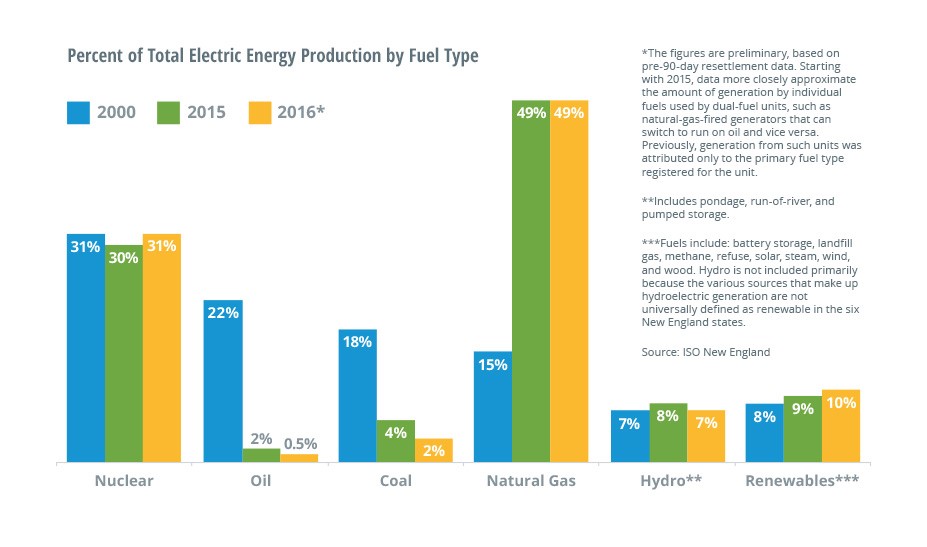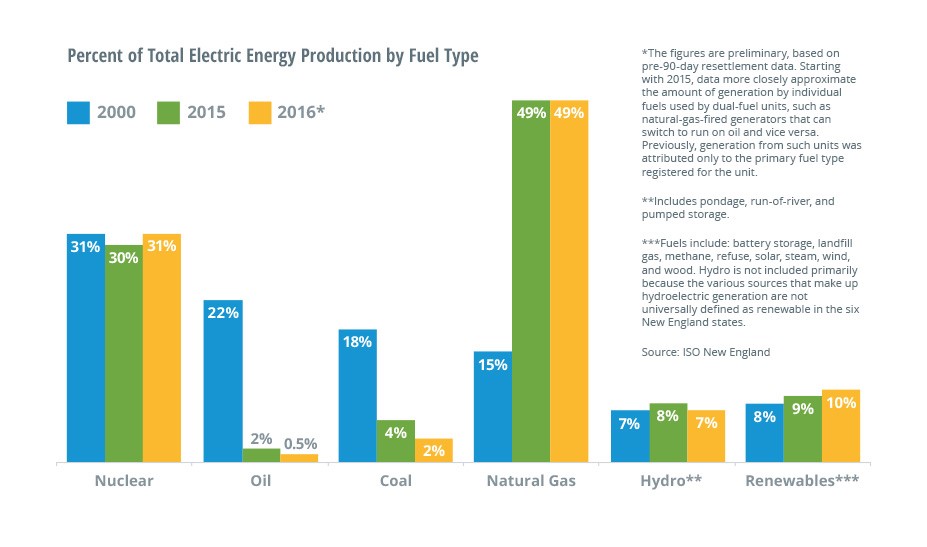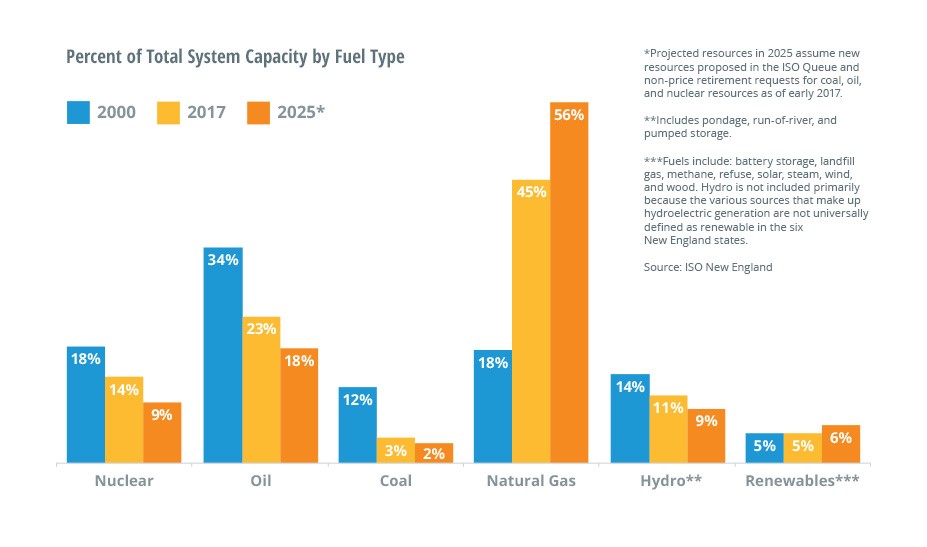New England’s Power Grid Transition: From Coal and Nuclear to Natural Gas and Renewable The Inconvenient Consequences
October 2, 2017

The power grid in New England is rapidly shifting from coal and nuclear energy to natural gas and renewable energy. Between 2012 and 2020, about 15% of the region’s generating capacity – more than 4,200 megawatts (MW)— is being replaced. Most of the new generating capacity is powered by new natural-gas-fired plants. But this does not mean extra capacity; many coal- and nuclear-powered plants are closing.
Good news: New plants are opening – capacity going up
Natural gas powers 52 percent of electricity production. With ample United States-based supplies and production, natural gas is the least expensive resource to generate electricity. Now, and in the near-future, gas simply makes more sense both economically and environmentally.
Mixed news: Older plants are closing – capacity going down
If we were adding gas plants to the mix without shuttering any plants, this story might be a little different.
But the upcoming closures of two of plants; Brayton Point Station (May 2017) and Pilgrim Nuclear Power Station (May 2019) will remove 2,200Â MW of non-gas-fired capacity. And they are not the only older plants at risk of closing.
About 9,000 MW of existing coal- and oil-fired energy plants are at risk or face uncertain futures.
The transition from coal, oil, and nuclear energy to natural gas and renewables have two underlying reasons: economics and the environment. From an economic standpoint, gas is less expensive than coal and nuclear power. And gas simply does not carry the same environmental impacts and costs. With this dual punch, over 5,500 MW of oil and coal capacity are at risk for retirement in coming years. And another 3,300 MW from the region’s remaining nuclear plants face an uncertain future.
Right now, there are only three other coal-fired power plants in New England – Merrimack Station (Bow, NH), Schiller Station (Portsmouth, NH), and Harbor Station (Bridgeport, CT ) – but they are also scheduled to be shut down in the near future. Harbor Station is expected to close in 2021 and be replaced by a natural gas plant.
Nuclear energy is also becoming extinct in New England.
New England’s two nuclear plants have closed or are scheduled to close. Pilgrim Nuclear Power Plant Station (Plymouth, MA) will close no later than June 2019. Vermont Yankee Nuclear Power Plant (Vernon, VT) closed 2014. Entergy, the operator of both these plants cite the high costs of the environmental risks associated with a nuclear plant, the low wholesale energy market prices, and the competing low costs of natural gas-based electrical generation.


Consequences and Realities.
While we can all agree that coal and nuclear power have environmental and economic consequences, there are problems with a large-scale shift to gas powered generation: fuel security.
Gas-fired electrical generation must compete for supply with domestic and commercial heating and cooking, and industrial usage. The Algonquin pipeline is the one primary pipeline bringing natural gas into New England – and it does not have enough capacity to meet the increased demand. This is especially true during the winter months when natural gas usage increases due to heating demand.
As you can see on the chart below, the cost of the transportation, or basis, spiked in the winter of 2014 – and dramatically impacted the market.

What are the solutions to a more stable supply?
More pipeline capacity. Increased natural gas transportation is critical but pipelines face incredible pressure from landowners and the public. Planning time is both long and complex.
Better storage technology for renewable energy. New energy-storage technologies are emerging in the region. In late 2015, grid-scale battery-storage projects requested interconnection to the regional power system for the first time. For renewable energy to be a reliable supplier, it must create adequate, scalable energy storate to meet baseload demand.
Better demand resources. Demand resources, such as load management, distributed generation, and energy-efficiency (EE) projects, have increased from 100 MW in 2003 to about 2,800 MW in 2017. This means that thousands of individual demand assets must be integrated into the power system.
While there are significant upward trends in renewables and EE, it will be years before these resources can match both current and planned/proposed gas-fired system capacity.
So…What does it all mean?
- Pay attention to the gas market. It will determine your energy costs and capabilities. Work with an energy consultant who is understands how the market impacts your cost.
- Pay attention to the weather. Cold weather – with increased heating demand – can impact supplies – and drive up prices.
- Investigate renewables – but understand the challenges. Installing your own renewables or net metering installations can mitigate fluctuations in the natural gas markets. But the state of the technology can make implementation a challenge.
- Invest in EE (energy efficiency). If you’re using less energy, you’re spending less. You face fewer impacts from price fluctuations due to natural gas supplies or the need to increase capacity of your renewable energy projects.
- Understand the impact of plants that are going off-line. Generation plant closings are announced well in advance. If your current power is being met with these closing plants, understand how this will impact your costs.
In closing…
Energy generation is changing in New England, moving away from nuclear-, oil- and coal-fired plants to gas-fired plants. This change is being driven by economics and environmental concerns. While renewables show long-term promise, they have their own set of issues around demand resources.
Gas-fired generation is currently the most economical fossil-fuel option, with lots of US-based capacity. But there are issues with pipeline capacity into New England.
To navigate the changing landscape of energy consumption, you need to look beyond your energy bill and understand the outside impacts of supply, weather, demands, and technology. Resources such as ASHE’s Energy University can help you navigate your power program. NEED MORE RESOURCES.
Working with an energy consultant can also help with understanding and taking advantage of market scale and future purchase price lock ins.
The market is changing – and you need to be proactive. Plan, understand, install EE, and diversify where you can. Use the resources of your professional groups and independent consultants so you can move confidently towards our new energy future.
Note: Written by Shaun Pandit and Edward Browne, Published in September 2017 New England Healthcare Engineer’s Society (NEHES) quarterly newsletter
